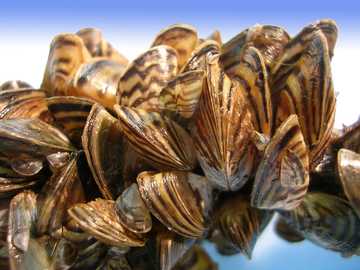

Additionally, by selectively avoiding toxic algae species like Microcystis, invasive mussels may help facilitate toxic algae blooms in lakes.Īs they filter water, invasive mussels retain water-borne toxins within their tissues, exposing mussel-eating fish and waterfowl to illnesses such as botulism. Increased water clarity caused by excessive filtration can also lead to a proliferation of benthic algae species, such as Cladophora, the decay of which contributes to foul-smelling “beach muck” seen across the Great Lakes. Some studies indicate that invasive mussels may even facilitate the establishment of other harmful invasive species like the rusty crayfish. Browse Getty Images premium collection of high-quality, authentic Zebra Mussels stock photos, royalty-free images, and pictures. The feeding of quagga mussels has dramatically reduced primary production in Lake Michigan and Lake Huron and has contributed to basin-wide population crashes of species which are fundamental to food webs and fisheries such as Diporeia, an invertebrate species. While invasive zebra mussels consume small plant-like organisms called phytoplankton, Michigan State University researchers discovered during a long-term study that zebra mussels can actually increase Microcystis, a type of phytoplankton known as blue-green algae or cyanobacteria, that. Water treatment plants and power plants sometimes become so overrun with mussels that they can't operate, adding billions of dollars to the cost of producing clean drinking water and electricity.Through filter feeding, invasive mussels reduce the amount of phytoplankton available for other organisms and increase water clarity, changing the structure of local aquatic communities. Long-term studies reveal a surprising relationship. Its presence has killed off native mussels and damaged docks and boats. It was found in the Great Lakes in 1988 and has since spread to connecting waterways in the U.S.

It is now found in Hungary, Britain, the Netherlands, Italy, Sweden, Spain and many other countries of Europe. The zebra mussel is considered native to the Black Sea and the Caspian Sea, but it has been transported to other parts of the world in the ballast of ships and attached to anchors, chains, and the bottoms of boats. Reference photographs of survey sites and other inter- esting or unique. While some organisms prey on them, such as crayfish, ducks, some species of fish, and muskrats, the mussels breed faster than predators can consume them. Zebra mussels and the closely related quagga mussel (Dreis- sena bugensis) have. Spawning zebra mussels can produce from 30,000 to a million eggs a year, making them extremely efficient breeders.

Once established, their colonies grow and they cover the entire surface of the object they're attached to, and pile on top of each other. They attach to any hard surfaces in freshwater, including rocks, concrete, pipes, screens, logs and boats. They start out tiny and grow to just under two inches. The data also showed that the numbers of. They survive best in water that is 6-28 degrees C (43-82 degrees F). The graphs showed that the zebra mussel population would increase and we see that dramatic increase in the picture. Zebra mussels have alternating light and dark brown stripes, but are sometimes all light or dark brown. Scientific classification | Kingdom: Animalia > Phylum: Mollusca > Class: Bivalvia > Subclass: Heterodonta > Order: Myida > Superfamily: Dreissenoidea > Family: Dreissenidae > Genus: Dreissena > Species: D. Zebra mussel images (Dreissena polymorpha) -stock photos & facts of this prolific freshwater mollusk


 0 kommentar(er)
0 kommentar(er)
